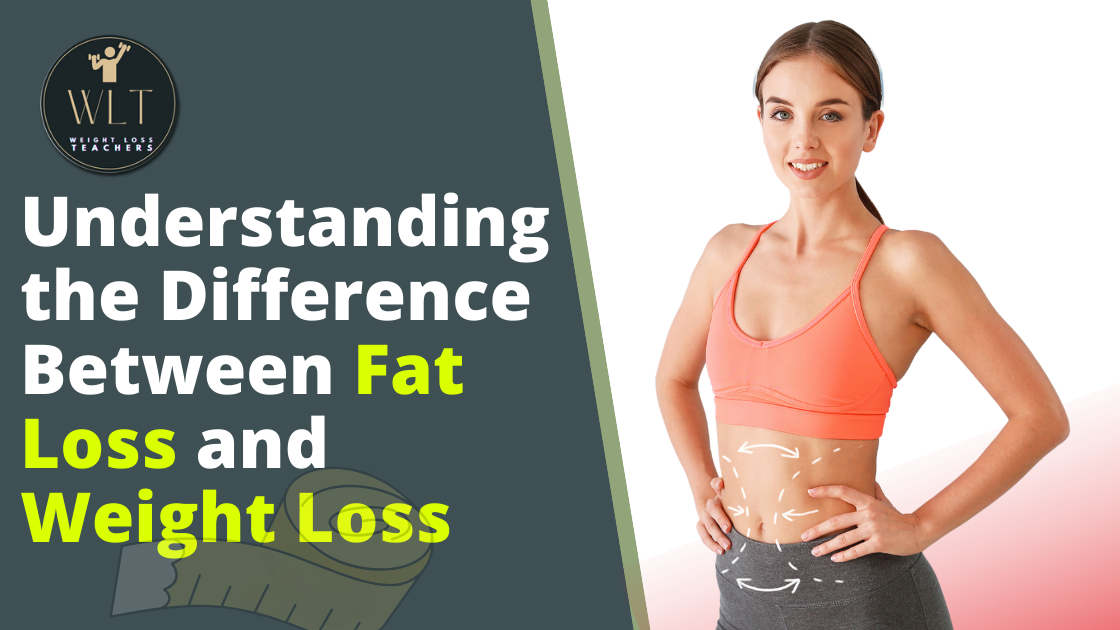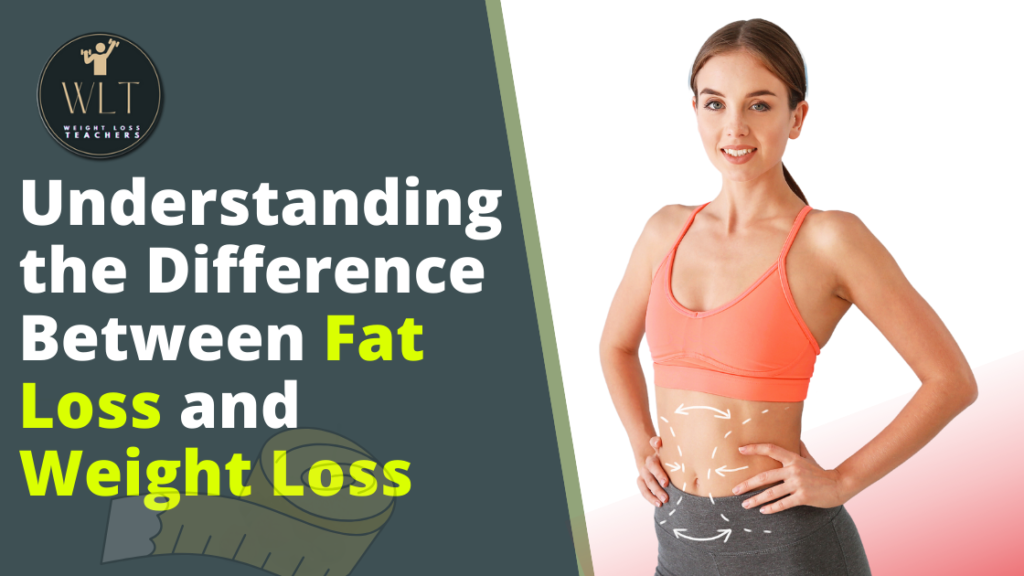
Understanding the Difference Between Fat Loss and Weight Loss

Weight loss and fat loss are two terms often used interchangeably, but they have distinct meanings and implications for achieving a healthy body composition. While weight loss refers to a decrease in overall body weight, fat loss specifically targets the reduction of excess body fat. Understanding this difference is essential for individuals striving to reach their health and fitness goals.
Table of Contents
Introduction
Weight loss is a common objective driven by factors such as improving appearance, boosting self-confidence, or addressing health concerns. However, it’s important to note that weight loss alone does not guarantee improved health or a desirable body composition.
Water weight loss is a phenomenon frequently observed at the start of weight loss journeys. It involves the loss of water stored in the body, often resulting from reduced carbohydrate intake or increased physical activity. While it may provide a temporary sense of progress, water weight loss is not a true reflection of fat loss and can be quickly regained.
Muscle mass loss is another misunderstood aspect of weight loss. Crash diets and extreme calorie restrictions can lead to muscle breakdown, negatively affecting strength, performance, and metabolism. Preserving lean muscle mass is vital for a healthy body composition and sustainable weight loss.
In contrast, fat loss focuses on reducing excess body fat while preserving muscle mass. Excess body fat poses health risks and is linked to obesity, cardiovascular diseases, diabetes, and certain cancers. Prioritizing fat loss over simple weight reduction is crucial for improving overall health and achieving a healthier body composition.
Therefore, understanding the difference between weight loss and fat loss is crucial for individuals aiming for optimal health. Fat loss, rather than simply reducing overall weight, should be the focus to achieve a healthier body composition and reduce the risks associated with excess body fat.

Difference between Weight Loss and Fat Loss

What is Weight Loss?
Weight loss primarily involves a decrease in overall body weight, which can be attributed to various factors such as loss of water, muscle mass, or fat. In many cases, weight loss is a goal for individuals looking to improve their health or appearance. However, it is important to note that weight loss alone does not necessarily equate to improved health or body composition.
Types of Weight Loss
- Water Weight Loss:
Initially, when embarking on a weight loss journey, the body may shed water weight due to factors like reduced carbohydrate intake or increased exercise. Water weight loss is temporary and can be quickly regained once regular eating habits are resumed.
Water weight loss is a common phenomenon observed in the initial stages of many weight loss programs. When individuals reduce their carbohydrate intake or increase their exercise levels, their bodies start utilizing glycogen stores for energy. Glycogen is stored in the muscles along with water. As the glycogen stores are depleted, the body excretes the excess water, resulting in a decrease in overall weight. While this may provide an immediate sense of progress, it is essential to understand that water weight loss is temporary and can be quickly regained once regular eating habits are resumed.
- Muscle Mass Loss
In certain cases, weight loss can result from a reduction in muscle mass. This can occur when individuals engage in crash diets or extreme caloric restriction without adequate protein intake or resistance exercise. Losing muscle mass can negatively impact metabolism and overall health.
Crash diets or extreme caloric restriction without proper consideration for protein intake and exercise can lead to muscle mass loss. This happens because the body starts breaking down muscle tissue to meet its energy needs when it is not adequately fueled. Muscle loss not only decreases strength and performance but also negatively affects metabolism. Since muscle tissue is metabolically active, the loss of muscle mass slows down the resting metabolic rate, making it harder to maintain weight loss in the long term.
Importance of Body Composition
- Body Mass Index (BMI)
BMI is a commonly used metric to assess weight status based on height and weight. However, it fails to consider body composition, as it does not differentiate between muscle mass and fat mass. Thus, it may not provide an accurate representation of an individual’s overall health.
Body Mass Index (BMI) is a widely used measurement to categorize individuals into weight status categories such as underweight, normal weight, overweight, or obese. However, BMI does not take into account the distribution of weight in terms of muscle mass and fat mass. For instance, athletes or individuals with a higher muscle mass may have a higher BMI, indicating overweight or obesity, even though they have a low body fat percentage and are metabolically healthy. On the other hand, individuals with a low BMI may have a high percentage of body fat, putting them at risk for health complications. Therefore, relying solely on BMI can be misleading when assessing overall health and body composition.
- Body Fat Percentage:
Calculating body fat percentage provides a more accurate assessment of one’s body composition. It determines the proportion of fat mass relative to overall weight and is a better indicator of health risks associated with excess body fat.
Body fat percentage is a more accurate measure of body composition and provides valuable information about the distribution of fat and lean mass in the body. By calculating body fat percentage, individuals can determine the proportion of their weight that is composed of fat mass. This measurement helps in identifying whether the weight loss goal should focus on reducing fat or muscle mass. Excessive body fat is associated with increased health risks, including cardiovascular diseases, diabetes, and metabolic disorders. Therefore, monitoring and reducing body fat percentage rather than solely focusing on weight loss can significantly contribute to improving overall health.
Understanding Fat Loss

Fat loss is a process that focuses specifically on reducing excess body fat while preserving lean muscle mass. This distinction is vital as excess body fat is associated with numerous health risks, including cardiovascular diseases, diabetes, and metabolic disorders.
The Role of Body Fat
Essential Fat vs. Storage Fat
The body requires essential fat to support physiological functions, such as hormone production and insulation. Storage fat, on the other hand, refers to the excess fat stored in adipose tissue.
Essential fat is necessary for the body to function optimally. It is the fat that is essential for physiological processes and is found in organs, bone marrow, and the central nervous system. Essential fat plays a crucial role in hormone production, insulation, and protection of vital organs. On the other hand, storage fat refers to the excess fat stored in adipose tissue throughout the body. This excess fat can accumulate due to a surplus of calorie intake compared to calorie expenditure.
Health Implications of Excess Body Fat
High levels of body fat are linked to an increased risk of various health conditions, including obesity, heart disease, stroke, and certain types of cancer.
Excessive body fat is associated with a higher risk of developing a range of health conditions. Obesity, defined as an excessive accumulation of body fat, is a major risk factor for cardiovascular diseases, including hypertension, heart disease, and stroke. The presence of excess body fat can contribute to insulin resistance and the development of type 2 diabetes. Furthermore, adipose tissue produces hormones and inflammatory substances that can disrupt normal physiological processes and increase the risk of chronic diseases, such as certain types of cancer.
Strategies for Effective Fat Loss
Caloric Balance
Achieving a negative caloric balance is crucial for fat loss. This means consuming fewer calories than expended, leading the body to utilize stored fat as an energy source.
Fat loss occurs when there is a calorie deficit, meaning that the energy expended exceeds the energy consumed. By creating a negative caloric balance, the body is forced to tap into its fat stores for energy, resulting in fat loss. This can be achieved through a combination of reducing calorie intake through mindful eating and increasing calorie expenditure through physical activity.
Balanced Diet
Emphasizing a nutrient-dense, balanced diet that includes lean proteins, whole grains, fruits, vegetables, and healthy fats supports fat loss while providing essential nutrients for overall health.
A balanced diet is crucial for effective fat loss while ensuring optimal nutrition. It should include a variety of nutrient-dense foods that provide essential vitamins, minerals, and macronutrients. Lean proteins, such as poultry, fish, legumes, and tofu, support muscle preservation and satiety. Whole grains, fruits, and vegetables provide fiber, antioxidants, and important micronutrients. Healthy fats, such as those found in avocados, nuts, and olive oil, contribute to satiety and provide essential fatty acids
Strength Training and Cardiovascular Exercise
Incorporating both strength training and cardiovascular exercises helps to increase lean muscle mass, boost metabolism, and burn calories efficiently.
Strength training and cardiovascular exercises are essential components of an effective fat loss program. Strength training exercises, such as weightlifting or bodyweight exercises, stimulate muscle growth and maintenance. Increased muscle mass leads to a higher resting metabolic rate, meaning that the body burns more calories even at rest. Cardiovascular exercises, such as running, cycling, or swimming, increase calorie expenditure, improve cardiovascular health, and contribute to overall fat loss.
Lifestyle Modifications
Addressing lifestyle factors such as sleep, stress management, and hydration are essential for optimizing fat loss efforts.
Beyond diet and exercise, lifestyle factors play a crucial role in achieving and maintaining fat loss. Adequate sleep is important, as lack of sleep can disrupt hormone levels, increase appetite, and impede fat loss efforts. Managing stress levels through techniques such as meditation or yoga can prevent emotional eating and support healthy behaviors. Hydration is also important, as it supports overall health, aids in digestion, and can help control appetite.
Note: There might be affiliate links mentioned here. We may receive a commission if you purchase a product through an affiliate link. There is no additional charge for you. Please do your own research before making any online purchases.
Differentiating Weight Loss and Fat Loss

Understanding the differences between weight loss and fat loss is crucial for setting realistic goals and adopting appropriate strategies. While weight loss may occur through various means, it is essential to focus on sustainable fat loss to achieve a healthier body composition.
Importance of Body Composition Analysis
Distinguishing Weight Loss and Fat Loss:
Body composition analysis, including measuring body fat percentage, can differentiate between weight loss and fat loss. This provides a clearer understanding of one’s progress toward a healthier body composition.
Body composition analysis allows individuals to differentiate between weight loss and fat loss. While weight loss focuses on overall body weight reduction, fat loss specifically targets the reduction of excess body fat. By measuring body fat percentage through methods such as dual-energy X-ray absorptiometry (DEXA), bioelectrical impedance analysis (BIA), or skinfold caliper measurements, individuals can track changes in body fat levels. This analysis provides a more accurate assessment of progress and ensures that weight loss efforts are primarily focused on fat reduction rather than muscle or water loss.
Scale vs. Mirror
Relying solely on the scale to gauge progress can be misleading since it does not distinguish between fat loss and other factors like water weight or muscle mass fluctuations. Using visual cues, such as looking in the mirror or assessing clothing fit, can complement scale measurements.
The scale is a common tool used to track weight loss progress. However, it should not be the sole determinant of success. The scale measures total body weight, which can fluctuate due to various factors like water retention, glycogen stores, or muscle gain. Therefore, it is important to use additional indicators to assess progress. Looking in the mirror and paying attention to changes in body shape and clothing fit can provide a more accurate representation of fat loss and body composition changes.
Long-Term Health and Sustainability
Health Risks of Crash Diets
Quick-fix diets or extreme caloric restrictions often result in rapid weight loss, primarily from muscle mass and water weight. Such approaches are unsustainable and can have adverse effects on overall health.
Crash diets or extreme caloric restrictions may lead to rapid weight loss in the short term, but they are not sustainable or healthy approaches. These approaches often result in the loss of muscle mass and water weight rather than fat loss. Losing muscle mass negatively affects metabolism and may lead to weight regain once normal eating habits are resumed. Furthermore, extreme caloric restrictions can deprive the body of essential nutrients, leading to nutritional deficiencies and potential health complications.
Focus on Fat Loss
Prioritizing fat loss over simple weight reduction promotes long-term health benefits, including improved metabolic health, reduced risk of chronic diseases, and enhanced overall well-being.
Shifting the focus from weight loss to fat loss promotes better long-term health outcomes. By prioritizing fat loss, individuals can improve metabolic health by reducing excess body fat, which is associated with increased risks of chronic diseases such as cardiovascular disease, diabetes, and certain cancers. Fat loss also leads to improved insulin sensitivity, better lipid profiles, and reduced inflammation markers. Additionally, achieving a healthier body composition positively impacts overall well-being, self-confidence, and body image.
FAQs (Frequently Asked Questions)
Q1. What is weight loss, and why is it a common objective for many people?
A1. Weight loss refers to a decrease in overall body weight and is a common goal for individuals looking to improve their health, boost self-confidence, or address health concerns related to excess body weight.
Q2. What is water weight loss, and why is it not a reliable indicator of fat loss?
A2. Water weight loss occurs at the start of weight loss journeys, often due to reduced carbohydrate intake or increased physical activity. It involves the loss of water stored in the body and is not a true reflection of fat loss since it can be quickly regained once regular eating habits are resumed.
Q3. How does muscle mass loss occur during weight loss, and why is it important to preserve lean muscle mass?
A3. Muscle mass loss can occur with crash diets or extreme calorie restrictions without adequate protein intake or resistance exercise. Preserving lean muscle mass is vital for a healthy body composition and sustainable weight loss, as muscle tissue plays a significant role in metabolism and overall health.
Q4. What is the difference between weight loss and fat loss, and why is body composition important?
A4. Weight loss focuses on decreasing overall body weight, while fat loss specifically targets the reduction of excess body fat. Body composition, which considers the proportion of fat mass and lean mass, is crucial for assessing health risks and achieving a desirable body composition.
Q5. How is Body Mass Index (BMI) used to assess weight status, and what are its limitations? A5. BMI is commonly used to categorize individuals into weight status categories, but it does not differentiate between muscle mass and fat mass. Therefore, it may not provide an accurate representation of an individual’s overall health and body composition.
Q6. Why is calculating body fat percentage a better indicator of health risks and fat loss progress?
A6. Body fat percentage provides a more accurate assessment of one’s body composition by determining the proportion of fat mass relative to overall weight. Monitoring and reducing body fat percentage can significantly contribute to improving overall health and achieving fat loss goals.
Q7. What are the health implications of excess body fat?
A7. Excessive body fat is associated with an increased risk of various health conditions, including obesity, cardiovascular diseases, diabetes, and certain types of cancer.
Q8. What strategies are effective for fat loss, and how does a balanced diet contribute to this goal?
A8. Effective fat loss can be achieved through a combination of creating a caloric deficit, emphasizing a nutrient-dense balanced diet, engaging in strength training and cardiovascular exercises, and addressing lifestyle factors such as sleep and stress management.
Q9. How can body composition analysis help differentiate between weight loss and fat loss?
A9. Body composition analysis, which includes measuring body fat percentage, helps distinguish between weight loss and fat loss. It provides a clearer understanding of progress toward a healthier body composition.
Q10. Why is it important to focus on fat loss rather than weight loss for long-term health and sustainability?
A10. Prioritizing fat loss over simple weight reduction promotes long-term health benefits, including improved metabolic health, reduced risk of chronic diseases, and enhanced overall well-being. Crash diets or extreme caloric restrictions are not sustainable and can have adverse effects on health.
Conclusion
Weight loss and fat loss may sound similar, but they carry distinct meanings and implications for overall health. While weight loss refers to a reduction in overall body weight, fat loss specifically targets the reduction of excess body fat. Understanding the differences between the two is vital for setting realistic goals and implementing effective strategies. By focusing on sustainable fat loss through balanced nutrition, strength training, and cardiovascular exercise, individuals can achieve a healthier body composition, reduce the risk of chronic diseases, and improve overall well-being. Remember, it’s not just about the number on the scale but the quality of the weight being lost.
Disclaimer: The information provided in this article is for educational purposes only and should not be considered as a substitute for medical advice. Consult a healthcare professional before implementing any home remedies or making significant changes to your lifestyle.






